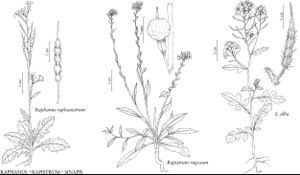Sinapis alba
Sp. Pl. 2: 668. 1753.
Plants usually hispid, rarely glabrous. Stems often branched distally, (1.5–)2.5–10(–22) dm. Basal leaves: petiole 1–3(–6) cm; blade oblong, ovate, or lanceolate (in outline), (3.5–)5–14(–20) cm × 20–60(–80) mm, margins lyrate, pinnatifid, pinnatisect; lobes 1–3 each side, (oblong, ovate, or lanceolate, 1.5–2.5 cm), margins usually dentate or repand, rarely pinnatifid. Cauline leaves (distal) shortly petiolate; blade (ovate or oblong-ovate, 2–4.5 cm), margins coarsely dentate, rarely subentire. Fruiting pedicels divaricate, (3–)6–12(–17) mm. Flowers: sepals (3.8–)4–7(–8) × 1–1.8 mm; petals pale yellow, (7–)8–12(–14) × (3–)4–6(–7) mm; filaments (3–)4–7(–8) mm; anthers 1.2–1.5 mm. Fruits lanceolate, (1.5–)2–4.2(–5) cm × (2–)3–5.5(–6.5) mm; valvular segment terete or slightly flattened, (0.5–)0.7–1.7(–2) cm, 2–5-seeded per locule; terminal segment ensiform, flattened, (1–)1.5–2.5(–3) cm, equal to or longer than valves, seedless; valves hispid, trichomes of 2 types (subsetiform mixed with shorter, slender ones). Seeds pale yellow to pale brown, (1.7–)2–3(–3.5) mm diam. 2n = 24.
Phenology: Flowering Mar–Sep.
Habitat: Escape from cultivation, roadsides, waste places, disturbed areas, grain fields, cultivated areas, gardens, orchards
Elevation: 0-1000 m
Distribution

Introduced; Greenland, Alta., B.C., Man., N.B., N.S., Ont., P.E.I., Que., Sask., Yukon, Ariz., Calif., Colo., Conn., Del., D.C., Ill., Ind., Iowa, Maine, Mass., Mich., Minn., Mo., Mont., Nebr., N.H., N.J., N.Mex., N.Y., N.C., N.Dak., Ohio, Okla., Oreg., Pa., R.I., S.C., S.Dak., Tenn., Tex., Utah, Vt., Wash., W.Va., Wis., Eurasia, introduced also in Mexico, Central America, South America (Argentina), Europe, sw Asia, n Africa, Atlantic Islands.
Discussion
Of the three subspecies of Sinapis alba recognized in European and North African floras, only subsp. alba is naturalized in the New World. This taxon is an important crop plant, and is occasionally reported as a weedy escape from cultivation. Its seeds are used for the manufacture of condiment mustard (see also 17. Brassica), pickling spice, and production of oils for soap and mayonnaise, lubrication, and cooking (I. A. Al-Shehbaz 1985).
Selected References
None.
